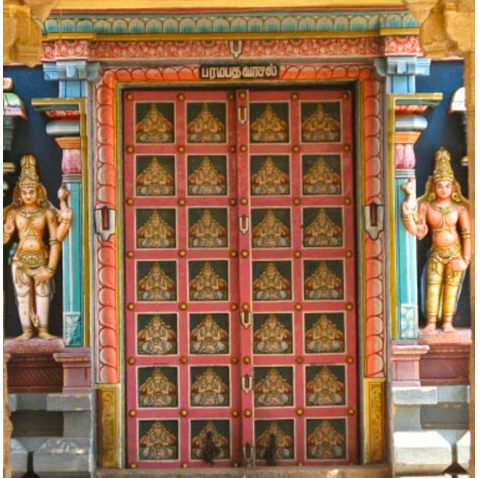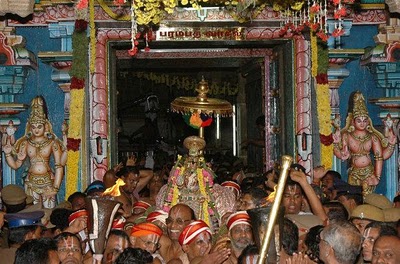On this day, fifteen minutes before the start of the procession (at the brahma muhurtham), the main gates leading to the sanctum the ARYA-BHATTAL-VASAL and the NAZHIKETTAN VASAL are closed until the Lord crosses the northern gate PXRAMAPALIA VASAL. The RAAPATHU UTSAVA is held for ten days and recitation of TIRUVAYMOZHI completed in ten nights at the rate of one hundred every night. The closing of these gates signify the cessation of the functions of the sense organs at the dissolution of the physical body.
This has relation to the SRI VAIKUNTA EKADASI UTSAVA because the festival on that day infact is conceived of as the journey of the mumukshu (one desirous of achieving liberation) to the Land of Eternal bliss and beauty. The focal point being that the Lord Himself plays the role of the mumuksha. The opening of the doors of the RANGA MANTAPA points to the final departure of the self from the body purely through the grace of the Lord through the sushumna-nadi (vein) and the Brahmandra (an opening in the skull). The journey of the mumukshu through the archiradi marga (path of light through which the soul travels) is vividly described by SRI NAMMAZHVAR in the ninth decad of the tenth centum of TIRUVAIMOZHI.
The entry of the mumuksbu through the cosmic regions is an event of over-riding importance and significance to the celestials who inhabit the seven upper worlds above earth. They vie with one another in according the reception to the devotee of NARAYANA (Narayanan-tamar). As he passes through the clouds, roar-music and waves in the ocean rise high and dance to a tune. Then the celestials ahead walk to offer purnakumba in shining gold vessels. Buntings and festoons enliven the atmosphere. (The denizens of the upper regions greet the arrival of the tama-r (devotee) by burning incense, showering flowers malung way through the rows for the devotee to pass through. The sages too join to welcome and bless the devotee alongside the VEDIC scholars. The devotee of the Lord who measured the earth (Bboomi-anni-alanthavan) is next received by the kinnara-s and GARUDA with celestial melody. The apsara-s (celestial maidens) hail, sing, dance and offer mangala aarti. Not to be left out, the Maruts and Vasus join the great procession which heralds the return of the self to the homeland.
At the gates of SRI VAIKUNTA, the devotee of GOVINDA is greeted by the nitya-s and mukta-s. They beseech the devotee to take their positions and duties. Even the chief of staff offers his whip as a token of great esteem. They wash his feet and he assumes a form appropriate there. In the great hall of everlasting bliss (ananda) the devotee is received by the Lord Himself and held in embrace.
On the concluding day of the festival indicated as Azhvar-mohsham the deity is taken to the holy tank, Chandrapushkarani. As the entire festival is treated as a sacrifice, all participants bathe in the sacred waters (avaprathasnana) of the tank. Bereft of all his belongings and wearing only a TULASI garland, the Azhvar is carried in their arms by the archaka-S and placed at the feet of the Lord indicating the plea for moksha has been accepted. Aradhanai is performed with TULASI leaves and before the Azhvar’s departure, the Lord honours him with His garland and other presents. The utsava ends with all the Azhvar-s duly honoured by the Lord who takes leave and reaches the sanctum.
Next day night the recitation of IYARPA commences and is concluded with sattumurai in the sanctum drawing the curtain down.
By VS Seshadri
Nrisimha Priya Series 2004










